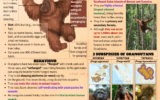
February 16 2024 Prelims Practice Questions (PPQ)
Subscribe to Never Miss an Important Update! Assured Discounts on New Products!
Must Join PMF IAS Telegram Channel & PMF IAS History Telegram Channel
- These Prelims Practice Questions (PPQs) are based on PMF IAS Daily Current Affairs.
- The daily current affairs are uploaded every day by 8 PM. You can read the Daily Current Affairs from here.
- Subscribers of the “Current Affairs” course can Download Daily Current Affairs in PDF/DOC from here.
[Quiz] Daily Prelims Practice Questions (PPQs) – February 16 2024
0 of 9 questions completed
Questions:
- 1
- 2
- 3
- 4
- 5
- 6
- 7
- 8
- 9
Information
These MCQs are based on PMF IAS Daily Current Affairs. The daily current affairs are uploaded every day by 8 PM. You can read the Daily Current Affairs from here. Subscribers of the “Current Affairs” course can Download Daily Current Affairs in PDF/DOC from here.
You have already completed the Test before. Hence you can not start it again.
Test is loading...
You must sign in or sign up to start the Test.
You have to finish following quiz, to start this Test:
Your results are here!! for" [Quiz] Daily Prelims Practice Questions (PPQs) – February 16 2024 "
0 of 9 questions answered correctly
Your time:
Time has elapsed
Your Final Score is : 0
You have attempted : 0
Number of Correct Questions : 0 and scored 0
Number of Incorrect Questions : 0 and Negative marks 0
| Average score |
|
| Your score |
|
-
Not categorized
You have attempted: 0
Number of Correct Questions: 0 and scored 0
Number of Incorrect Questions: 0 and Negative marks 0
| Pos. | Name | Entered on | Points | Result |
|---|---|---|---|---|
| Table is loading | ||||
| No data available | ||||
- 1
- 2
- 3
- 4
- 5
- 6
- 7
- 8
- 9
- Answered
- Review
-
Question 1 of 9
1. Question
Q1. {IE – Resources} Consider the following statements about National Coal Index (NCI):
- It is a price index that is annually released by the Ministry of Coal and incorporates prices from all sales channels such as Notified Prices, Auction Prices and Import Prices.
- The concept and design of the Index is developed by the Central Mine Planning and Design Institute (CMPDI).
- The downward trajectory of the NCI signifies a less equitable market and impeding supply.
How many of the above statement(s) is/are incorrect?
Correct
Explanation
Statement 1 is incorrect
- The National Coal Index (NCI) is a price index that combines coal prices from all sales channels such as Notified Prices, Auction Prices and Import Prices.
- It serves as a reliable indicator of market dynamics, providing valuable insights of price fluctuations.
- In the auction process, the National Coal Index (NCI) and Representative Prices (RP) would play very important role.
- It is released by the Ministry of Coal every month.
Statement 2 is incorrect
- The concept and design of the Index have been developed by the Indian Statistical Institute, Kolkata.
- It considers prices of coking and non-coking coal of various grades transacted in the regulated (power and fertilizer) and non-regulated sectors.
Statement 3 is incorrect
- The base year of the index is Financial Year 2017-18.
- The peak of NCI was observed in June 2022 when the index reached 238.83 points, but subsequent months have experienced a decline, indicative of abundant availability of coal in the Indian market.
- The downward trajectory of the NCI signifies a more equitable market, harmonizing supply and demand dynamics.
Answer: (c) All; Difficulty Level: Medium
Incorrect
Explanation
Statement 1 is incorrect
- The National Coal Index (NCI) is a price index that combines coal prices from all sales channels such as Notified Prices, Auction Prices and Import Prices.
- It serves as a reliable indicator of market dynamics, providing valuable insights of price fluctuations.
- In the auction process, the National Coal Index (NCI) and Representative Prices (RP) would play very important role.
- It is released by the Ministry of Coal every month.
Statement 2 is incorrect
- The concept and design of the Index have been developed by the Indian Statistical Institute, Kolkata.
- It considers prices of coking and non-coking coal of various grades transacted in the regulated (power and fertilizer) and non-regulated sectors.
Statement 3 is incorrect
- The base year of the index is Financial Year 2017-18.
- The peak of NCI was observed in June 2022 when the index reached 238.83 points, but subsequent months have experienced a decline, indicative of abundant availability of coal in the Indian market.
- The downward trajectory of the NCI signifies a more equitable market, harmonizing supply and demand dynamics.
Answer: (c) All; Difficulty Level: Medium
Unattempted
Explanation
Statement 1 is incorrect
- The National Coal Index (NCI) is a price index that combines coal prices from all sales channels such as Notified Prices, Auction Prices and Import Prices.
- It serves as a reliable indicator of market dynamics, providing valuable insights of price fluctuations.
- In the auction process, the National Coal Index (NCI) and Representative Prices (RP) would play very important role.
- It is released by the Ministry of Coal every month.
Statement 2 is incorrect
- The concept and design of the Index have been developed by the Indian Statistical Institute, Kolkata.
- It considers prices of coking and non-coking coal of various grades transacted in the regulated (power and fertilizer) and non-regulated sectors.
Statement 3 is incorrect
- The base year of the index is Financial Year 2017-18.
- The peak of NCI was observed in June 2022 when the index reached 238.83 points, but subsequent months have experienced a decline, indicative of abundant availability of coal in the Indian market.
- The downward trajectory of the NCI signifies a more equitable market, harmonizing supply and demand dynamics.
Answer: (c) All; Difficulty Level: Medium
-
Question 2 of 9
2. Question
Q2. {Prelims – In News} Consider the following statements about Conscription:
- It is a compulsory enrollment for service in a country’s armed forces.
- The Indian constitution has a provision in Article 23 that allows the government to mandate Conscription.
- In India conscription was mandated in the year 1962 during the Sino-India War.
How many of the above statement(s) is/are correct?
Correct
Explanation
Statement 1 is correct
- Conscription is the compulsory enrollment for service in a country’s armed forces.
- It has existed at least from the time of the Egyptian Old Kingdom (27th century BCE).
- The 1st comprehensive nationwide conscription was instituted by the French Republic in the wars following the French Revolution and was institutionalized by Napoleon after he became emperor in 1803.
Statement 2 is correct
- India has always had a voluntary armed force without any conscription laws.
- The Indian constitution has a provision in Article 23 that allows the government to mandate Conscription in the interest of national security and public welfare.
Statement 3 is incorrect
- India has never applied this provision.
Answer: (b) Only two; Difficulty Level: Medium
Incorrect
Explanation
Statement 1 is correct
- Conscription is the compulsory enrollment for service in a country’s armed forces.
- It has existed at least from the time of the Egyptian Old Kingdom (27th century BCE).
- The 1st comprehensive nationwide conscription was instituted by the French Republic in the wars following the French Revolution and was institutionalized by Napoleon after he became emperor in 1803.
Statement 2 is correct
- India has always had a voluntary armed force without any conscription laws.
- The Indian constitution has a provision in Article 23 that allows the government to mandate Conscription in the interest of national security and public welfare.
Statement 3 is incorrect
- India has never applied this provision.
Answer: (b) Only two; Difficulty Level: Medium
Unattempted
Explanation
Statement 1 is correct
- Conscription is the compulsory enrollment for service in a country’s armed forces.
- It has existed at least from the time of the Egyptian Old Kingdom (27th century BCE).
- The 1st comprehensive nationwide conscription was instituted by the French Republic in the wars following the French Revolution and was institutionalized by Napoleon after he became emperor in 1803.
Statement 2 is correct
- India has always had a voluntary armed force without any conscription laws.
- The Indian constitution has a provision in Article 23 that allows the government to mandate Conscription in the interest of national security and public welfare.
Statement 3 is incorrect
- India has never applied this provision.
Answer: (b) Only two; Difficulty Level: Medium
-
Question 3 of 9
3. Question
Q3. {IR – International Treaties} Consider the following statements with respect to the European Free Trade Association (EFTA):
- All members of the European Union are members of the EFTA.
- Trade and Economic Partnership Agreement (TEPA) is the agreement that promotes investment between member countries.
Which of the above statement(s) is/are correct?
Correct
Explanation
Statement 1 is incorrect
- EFTA is an intergovernmental organization that was established in 1960 as an alternative trade bloc for those European states that were unable or unwilling to join the European Union (EU).
- EFTA comprises Iceland, Liechtenstein, Norway, and Switzerland, which are not part of the EU but have access to its single market through various agreements.

- EFTA is India’s 9th largest trading partner, accounting for about 2.5% of India’s total merchandise trade in 2020-21.
- The main items of India’s exports to EFTA are textiles, chemicals, gems, and jewellery, machinery, and pharmaceuticals.
- The main items of India’s imports from EFTA are machinery, chemicals, precious metals, and medical instruments.
Statement 2 is correct
- Trade and Economic Partnership Agreement (TEPA) is a type of trade agreement that aims to promote trade and investment between two or more countries.
- It typically covers a wide range of issues related to trade, including the reduction or elimination of tariffs, the removal of non-tariff barriers, and the facilitation of investment and services trade.
- The TEPA negotiations between EFTA states and India aim to enhance trade and economic cooperation between the two parties.
Answer: (b) 2 Only; Difficulty Level: Medium
Incorrect
Explanation
Statement 1 is incorrect
- EFTA is an intergovernmental organization that was established in 1960 as an alternative trade bloc for those European states that were unable or unwilling to join the European Union (EU).
- EFTA comprises Iceland, Liechtenstein, Norway, and Switzerland, which are not part of the EU but have access to its single market through various agreements.

- EFTA is India’s 9th largest trading partner, accounting for about 2.5% of India’s total merchandise trade in 2020-21.
- The main items of India’s exports to EFTA are textiles, chemicals, gems, and jewellery, machinery, and pharmaceuticals.
- The main items of India’s imports from EFTA are machinery, chemicals, precious metals, and medical instruments.
Statement 2 is correct
- Trade and Economic Partnership Agreement (TEPA) is a type of trade agreement that aims to promote trade and investment between two or more countries.
- It typically covers a wide range of issues related to trade, including the reduction or elimination of tariffs, the removal of non-tariff barriers, and the facilitation of investment and services trade.
- The TEPA negotiations between EFTA states and India aim to enhance trade and economic cooperation between the two parties.
Answer: (b) 2 Only; Difficulty Level: Medium
Unattempted
Explanation
Statement 1 is incorrect
- EFTA is an intergovernmental organization that was established in 1960 as an alternative trade bloc for those European states that were unable or unwilling to join the European Union (EU).
- EFTA comprises Iceland, Liechtenstein, Norway, and Switzerland, which are not part of the EU but have access to its single market through various agreements.

- EFTA is India’s 9th largest trading partner, accounting for about 2.5% of India’s total merchandise trade in 2020-21.
- The main items of India’s exports to EFTA are textiles, chemicals, gems, and jewellery, machinery, and pharmaceuticals.
- The main items of India’s imports from EFTA are machinery, chemicals, precious metals, and medical instruments.
Statement 2 is correct
- Trade and Economic Partnership Agreement (TEPA) is a type of trade agreement that aims to promote trade and investment between two or more countries.
- It typically covers a wide range of issues related to trade, including the reduction or elimination of tariffs, the removal of non-tariff barriers, and the facilitation of investment and services trade.
- The TEPA negotiations between EFTA states and India aim to enhance trade and economic cooperation between the two parties.
Answer: (b) 2 Only; Difficulty Level: Medium
-
Question 4 of 9
4. Question
Q4. {Ministry – Initiatives} Consider the following statements with respect to the State of India’s Digital Economy (SIDE) Report, 2024:
- It is annually released by the Niti Aayog along the lines of E-Government Development Index of the United Nations.
- The ranking is based on the 5 pillars of Connect, Harness, Innovate, Protect and Sustain (CHIPS) framework.
- India is the third largest digitized country in the world after the US and China.
How many of the above statement(s) is/are correct?
Correct
Explanation
Statement 1 is incorrect
- The report is released by the Indian Council for Research on International Economic Relations (ICRIER).
- The report is based on a new approach to measure digitalization by recognizing the scale of the network and depth of use of technology at the economy wide level to arrive at its conclusions.
- Other established global indices that focus entirely on the average users are:
- E-Government Development Index (EGDI) of the United Nations
- Network Readiness Index (NRI) of Harvard University
- ICT Development Index (IDI) of International Telecommunication Union
Statement 2 is correct
- Using a new approach called the CHIPS (connect-harness-innovate-protect-sustain) the report benchmarked the scale and depth of India’s digital transformation with respect to G20 countries as well as for Indian states and UTs.
- This approach is better suited for developing countries like India as it captures both the opportunities and risks created by digitalisation.
Statement 3 is correct
- In the SIDE 2024 report, the US ranks first with a score of 65 and China a close second with 62, India is third with a score of 39, followed by the UK (29), Germany (24) and South Korea (22).
- However, while India as a nation is vastly digitalised, the average user is not, a reason why India is ranked 12th among the G20 countries in terms of level of digitalisation of the user.
- India’s gender gap in internet connectivity at 10%, is higher than the world average of 9%.
- The rural-urban divide is at 58%, vis-à-vis the world average at 49%.
Answer: (b) Only two; Difficulty Level: Medium
Incorrect
Explanation
Statement 1 is incorrect
- The report is released by the Indian Council for Research on International Economic Relations (ICRIER).
- The report is based on a new approach to measure digitalization by recognizing the scale of the network and depth of use of technology at the economy wide level to arrive at its conclusions.
- Other established global indices that focus entirely on the average users are:
- E-Government Development Index (EGDI) of the United Nations
- Network Readiness Index (NRI) of Harvard University
- ICT Development Index (IDI) of International Telecommunication Union
Statement 2 is correct
- Using a new approach called the CHIPS (connect-harness-innovate-protect-sustain) the report benchmarked the scale and depth of India’s digital transformation with respect to G20 countries as well as for Indian states and UTs.
- This approach is better suited for developing countries like India as it captures both the opportunities and risks created by digitalisation.
Statement 3 is correct
- In the SIDE 2024 report, the US ranks first with a score of 65 and China a close second with 62, India is third with a score of 39, followed by the UK (29), Germany (24) and South Korea (22).
- However, while India as a nation is vastly digitalised, the average user is not, a reason why India is ranked 12th among the G20 countries in terms of level of digitalisation of the user.
- India’s gender gap in internet connectivity at 10%, is higher than the world average of 9%.
- The rural-urban divide is at 58%, vis-à-vis the world average at 49%.
Answer: (b) Only two; Difficulty Level: Medium
Unattempted
Explanation
Statement 1 is incorrect
- The report is released by the Indian Council for Research on International Economic Relations (ICRIER).
- The report is based on a new approach to measure digitalization by recognizing the scale of the network and depth of use of technology at the economy wide level to arrive at its conclusions.
- Other established global indices that focus entirely on the average users are:
- E-Government Development Index (EGDI) of the United Nations
- Network Readiness Index (NRI) of Harvard University
- ICT Development Index (IDI) of International Telecommunication Union
Statement 2 is correct
- Using a new approach called the CHIPS (connect-harness-innovate-protect-sustain) the report benchmarked the scale and depth of India’s digital transformation with respect to G20 countries as well as for Indian states and UTs.
- This approach is better suited for developing countries like India as it captures both the opportunities and risks created by digitalisation.
Statement 3 is correct
- In the SIDE 2024 report, the US ranks first with a score of 65 and China a close second with 62, India is third with a score of 39, followed by the UK (29), Germany (24) and South Korea (22).
- However, while India as a nation is vastly digitalised, the average user is not, a reason why India is ranked 12th among the G20 countries in terms of level of digitalisation of the user.
- India’s gender gap in internet connectivity at 10%, is higher than the world average of 9%.
- The rural-urban divide is at 58%, vis-à-vis the world average at 49%.
Answer: (b) Only two; Difficulty Level: Medium
-
Question 5 of 9
5. Question
Q5. {Prelims – S&T – Biotech} Consider the following statements about Stem Cell Therapy:
- It primarily relies on induced pluripotent stem cells, which are manipulated to differentiate into specific cell types for therapeutic purposes.
- It involves the use of specialized cells to replace or repair damaged tissues, offering a promising approach for medical treatment.
Which of the above statement(s) is/are incorrect?
Correct
Explanation
Statement 1 is incorrect
- Currently, most stem cell therapy utilizes adult stem cells found in blood, bone marrow, or fat tissues. These are readily available and less ethically controversial than embryonic stem cells (ESCs).
- induced Pluripotent Stem Cells (iPSC) development: While iPSCs, created by reprogramming adult cells to an embryonic-like state, offer potential advantages, they are still in their early stages of clinical development and face challenges like potential tumour formation.
- Limited applications: The use of iPSCs in current approved stem cell therapies is minimal, with most available treatments relying on adult stem cells.
- Therefore, while Stem Cell Therapy is promising, relying primarily on iPSCs is not an accurate representation of its current state.
Statement 2 is correct
- Stem cells are the body’s raw materials, cells from which all other cells with specialized functions are generated.
- Under the right conditions in the body or a laboratory, stem cells divide to form more cells called daughter cells.
- Stem cell therapy, also known as regenerative medicine, promotes the repair response of diseased, dysfunctional or injured tissue using stem cells or their derivatives.
- Stem cells can then be implanted into a person.
- For example, Mumbai baby boy was injected with 40 million stem cells and gradually the lungs began to repair. In this case, doctors used mesenchymal stem-cell therapy (these are adult stem cells and are different from Embryonic stem cells) on an experimental basis.
- Through more equitable investments, researchers hope menstruation will be recognised as a new frontier in regenerative medicine.
Answer: (a) 1 Only; Difficulty Level: Medium
Incorrect
Explanation
Statement 1 is incorrect
- Currently, most stem cell therapy utilizes adult stem cells found in blood, bone marrow, or fat tissues. These are readily available and less ethically controversial than embryonic stem cells (ESCs).
- induced Pluripotent Stem Cells (iPSC) development: While iPSCs, created by reprogramming adult cells to an embryonic-like state, offer potential advantages, they are still in their early stages of clinical development and face challenges like potential tumour formation.
- Limited applications: The use of iPSCs in current approved stem cell therapies is minimal, with most available treatments relying on adult stem cells.
- Therefore, while Stem Cell Therapy is promising, relying primarily on iPSCs is not an accurate representation of its current state.
Statement 2 is correct
- Stem cells are the body’s raw materials, cells from which all other cells with specialized functions are generated.
- Under the right conditions in the body or a laboratory, stem cells divide to form more cells called daughter cells.
- Stem cell therapy, also known as regenerative medicine, promotes the repair response of diseased, dysfunctional or injured tissue using stem cells or their derivatives.
- Stem cells can then be implanted into a person.
- For example, Mumbai baby boy was injected with 40 million stem cells and gradually the lungs began to repair. In this case, doctors used mesenchymal stem-cell therapy (these are adult stem cells and are different from Embryonic stem cells) on an experimental basis.
- Through more equitable investments, researchers hope menstruation will be recognised as a new frontier in regenerative medicine.
Answer: (a) 1 Only; Difficulty Level: Medium
Unattempted
Explanation
Statement 1 is incorrect
- Currently, most stem cell therapy utilizes adult stem cells found in blood, bone marrow, or fat tissues. These are readily available and less ethically controversial than embryonic stem cells (ESCs).
- induced Pluripotent Stem Cells (iPSC) development: While iPSCs, created by reprogramming adult cells to an embryonic-like state, offer potential advantages, they are still in their early stages of clinical development and face challenges like potential tumour formation.
- Limited applications: The use of iPSCs in current approved stem cell therapies is minimal, with most available treatments relying on adult stem cells.
- Therefore, while Stem Cell Therapy is promising, relying primarily on iPSCs is not an accurate representation of its current state.
Statement 2 is correct
- Stem cells are the body’s raw materials, cells from which all other cells with specialized functions are generated.
- Under the right conditions in the body or a laboratory, stem cells divide to form more cells called daughter cells.
- Stem cell therapy, also known as regenerative medicine, promotes the repair response of diseased, dysfunctional or injured tissue using stem cells or their derivatives.
- Stem cells can then be implanted into a person.
- For example, Mumbai baby boy was injected with 40 million stem cells and gradually the lungs began to repair. In this case, doctors used mesenchymal stem-cell therapy (these are adult stem cells and are different from Embryonic stem cells) on an experimental basis.
- Through more equitable investments, researchers hope menstruation will be recognised as a new frontier in regenerative medicine.
Answer: (a) 1 Only; Difficulty Level: Medium
-
Question 6 of 9
6. Question
Q6. {Ministry – Initiatives} Which of the following statement provides the most accurate description of the functioning of the Production Linked Incentive (PLI) Scheme?
Correct
Explanation
- The PLI Scheme is an initiative by the Government of India to incentivize domestic manufacturing and boost the country’s industrial growth.
- Under this scheme, eligible companies receive financial incentives in the form of cash subsidies based on their incremental sales of manufactured goods over a specified base year.
- The scheme aims to encourage companies to increase their production capacity, enhance competitiveness, and attract investment in various sectors, including electronics, pharmaceuticals, automobiles, and textiles.
Answer: (c) Companies receive financial incentives based on their incremental sales over a predefined base year; Difficulty Level: Medium
Incorrect
Explanation
- The PLI Scheme is an initiative by the Government of India to incentivize domestic manufacturing and boost the country’s industrial growth.
- Under this scheme, eligible companies receive financial incentives in the form of cash subsidies based on their incremental sales of manufactured goods over a specified base year.
- The scheme aims to encourage companies to increase their production capacity, enhance competitiveness, and attract investment in various sectors, including electronics, pharmaceuticals, automobiles, and textiles.
Answer: (c) Companies receive financial incentives based on their incremental sales over a predefined base year; Difficulty Level: Medium
Unattempted
Explanation
- The PLI Scheme is an initiative by the Government of India to incentivize domestic manufacturing and boost the country’s industrial growth.
- Under this scheme, eligible companies receive financial incentives in the form of cash subsidies based on their incremental sales of manufactured goods over a specified base year.
- The scheme aims to encourage companies to increase their production capacity, enhance competitiveness, and attract investment in various sectors, including electronics, pharmaceuticals, automobiles, and textiles.
Answer: (c) Companies receive financial incentives based on their incremental sales over a predefined base year; Difficulty Level: Medium
-
Question 7 of 9
7. Question
Q7. {Prelims – S&T – In News} Which one of the following is the primary objective of the Transiting Exoplanet Survey Satellite (TESS)?
Correct
Explanation
- The primary objective of the Transiting Exoplanet Survey Satellite (TESS) is to discover new exoplanets using the transit method.
- TESS is a space telescope designed to search for exoplanets by monitoring the brightness of stars for periodic dips in light caused by planets passing in front of them, or transiting.
- It is a NASA mission dedicated to locating planets that orbit the brightest stars visible from Earth.
- It is a successor to NASA’s Kepler space telescope, which discovered thousands of exoplanets over a decade following its launch in 2009.
- TESS discovers planets of various sizes and compositions, from small rocky ones to giant ones, demonstrating the galaxy’s planet diversity.
Answer: (c) Discover new exoplanets using the transit method; Difficulty Level: Medium
Incorrect
Explanation
- The primary objective of the Transiting Exoplanet Survey Satellite (TESS) is to discover new exoplanets using the transit method.
- TESS is a space telescope designed to search for exoplanets by monitoring the brightness of stars for periodic dips in light caused by planets passing in front of them, or transiting.
- It is a NASA mission dedicated to locating planets that orbit the brightest stars visible from Earth.
- It is a successor to NASA’s Kepler space telescope, which discovered thousands of exoplanets over a decade following its launch in 2009.
- TESS discovers planets of various sizes and compositions, from small rocky ones to giant ones, demonstrating the galaxy’s planet diversity.
Answer: (c) Discover new exoplanets using the transit method; Difficulty Level: Medium
Unattempted
Explanation
- The primary objective of the Transiting Exoplanet Survey Satellite (TESS) is to discover new exoplanets using the transit method.
- TESS is a space telescope designed to search for exoplanets by monitoring the brightness of stars for periodic dips in light caused by planets passing in front of them, or transiting.
- It is a NASA mission dedicated to locating planets that orbit the brightest stars visible from Earth.
- It is a successor to NASA’s Kepler space telescope, which discovered thousands of exoplanets over a decade following its launch in 2009.
- TESS discovers planets of various sizes and compositions, from small rocky ones to giant ones, demonstrating the galaxy’s planet diversity.
Answer: (c) Discover new exoplanets using the transit method; Difficulty Level: Medium
-
Question 8 of 9
8. Question
Q8. {Ministry – Initiatives} Sangam Initiative, recently seen in news, is launched by?
Correct
Explanation
- The Department of Telecommunications (DoT) under Ministry of Communication has unveiled the ‘Sangam: Digital Twin’ initiative, inviting Expressions of Interest (EoI) from various sectors.
- Digital Twin Initiative is a Proof of Concept (PoC) distributed in two stages:
- The first stage is exploratory for clarity of horizon and creative exploration to unleash potential.
- The second stage is for practical demonstration of specific use cases generating a future blueprint that may serve as a roadmap to scale and replicate successful strategies in future infrastructure projects through collaboration.
- Digital Twin symbolises a collaborative leap towards reshaping infrastructure planning and design, combining the prowess of 5G, IoT, AI, AR/VR, AI native 6G, Digital Twin and next-gen computational technologies with the collective intelligence of public entities, infrastructure planners, tech giants, startups, and academia to break the silos and engage in a whole-of-nation approach.
- Sangam brings all stakeholders on one platform aiming to transform innovative ideas into tangible solutions, bridging the gap between conceptualization and realisation, ultimately paving the way for groundbreaking infrastructure advancements.
Answer: (c) Ministry of Communication; Difficulty Level: Medium
Incorrect
Explanation
- The Department of Telecommunications (DoT) under Ministry of Communication has unveiled the ‘Sangam: Digital Twin’ initiative, inviting Expressions of Interest (EoI) from various sectors.
- Digital Twin Initiative is a Proof of Concept (PoC) distributed in two stages:
- The first stage is exploratory for clarity of horizon and creative exploration to unleash potential.
- The second stage is for practical demonstration of specific use cases generating a future blueprint that may serve as a roadmap to scale and replicate successful strategies in future infrastructure projects through collaboration.
- Digital Twin symbolises a collaborative leap towards reshaping infrastructure planning and design, combining the prowess of 5G, IoT, AI, AR/VR, AI native 6G, Digital Twin and next-gen computational technologies with the collective intelligence of public entities, infrastructure planners, tech giants, startups, and academia to break the silos and engage in a whole-of-nation approach.
- Sangam brings all stakeholders on one platform aiming to transform innovative ideas into tangible solutions, bridging the gap between conceptualization and realisation, ultimately paving the way for groundbreaking infrastructure advancements.
Answer: (c) Ministry of Communication; Difficulty Level: Medium
Unattempted
Explanation
- The Department of Telecommunications (DoT) under Ministry of Communication has unveiled the ‘Sangam: Digital Twin’ initiative, inviting Expressions of Interest (EoI) from various sectors.
- Digital Twin Initiative is a Proof of Concept (PoC) distributed in two stages:
- The first stage is exploratory for clarity of horizon and creative exploration to unleash potential.
- The second stage is for practical demonstration of specific use cases generating a future blueprint that may serve as a roadmap to scale and replicate successful strategies in future infrastructure projects through collaboration.
- Digital Twin symbolises a collaborative leap towards reshaping infrastructure planning and design, combining the prowess of 5G, IoT, AI, AR/VR, AI native 6G, Digital Twin and next-gen computational technologies with the collective intelligence of public entities, infrastructure planners, tech giants, startups, and academia to break the silos and engage in a whole-of-nation approach.
- Sangam brings all stakeholders on one platform aiming to transform innovative ideas into tangible solutions, bridging the gap between conceptualization and realisation, ultimately paving the way for groundbreaking infrastructure advancements.
Answer: (c) Ministry of Communication; Difficulty Level: Medium
-
Question 9 of 9
9. Question
Q9. {S&T – Sci} Consider the following statements about Nuclear Fusion:
- It is defined as the combining of several small nuclei into one large nucleus with the subsequent release of huge amounts of energy.
- Nuclear fusion reactions take place in a state of matter called plasma.
- Joint European Torus (JET) is the first device to achieve controlled fusion power using deuterium and tritium.
How many of the above statement(s) is/are correct?
Correct
Explanation
Statement 1 is correct
- Nuclear fusion is defined as the combining of several small nuclei into one large nucleus with the subsequent release of huge amounts of energy.
- It is the opposite reaction of fission, where heavy isotopes are split apart.
Statement 2 is correct
- Fusion reactions take place in a state of matter called plasma.
- Plasma is a hot, charged gas made of positive ions and free-moving electrons that has unique properties distinct from solids, liquids and gases.
- At high temperatures, electrons are ripped from atom’s nuclei and become a plasma or an ionised state of matter.
- Plasma is also known as the fourth state of matter.
Statement 3 is correct
- Joint European Torus (JET) in the UK is a large tokamak, the first device to achieve controlled fusion power using deuterium and tritium.
- The Joint European Torus (JET) in Oxfordshire began operating in 1983.
- When running, it was temporarily the hottest point in the solar system, reaching 150 million°C.
- The reactor’s previous record was a reaction lasting for 5 seconds in 2021, producing 59 megajoules of heat energy.
- But in its final tests in late 2023, it surpassed this by sustaining a reaction for 5.2 seconds while also reaching 69 megajoules of output, using just 0.2 milligrams of fuel.
- A larger and more modern replacement for JET, the International Thermonuclear Experimental Reactor (ITER) in France, is nearing completion and its first experiments are due to start in 2025.
Answer: (c) All; Difficulty Level: Easy
Incorrect
Explanation
Statement 1 is correct
- Nuclear fusion is defined as the combining of several small nuclei into one large nucleus with the subsequent release of huge amounts of energy.
- It is the opposite reaction of fission, where heavy isotopes are split apart.
Statement 2 is correct
- Fusion reactions take place in a state of matter called plasma.
- Plasma is a hot, charged gas made of positive ions and free-moving electrons that has unique properties distinct from solids, liquids and gases.
- At high temperatures, electrons are ripped from atom’s nuclei and become a plasma or an ionised state of matter.
- Plasma is also known as the fourth state of matter.
Statement 3 is correct
- Joint European Torus (JET) in the UK is a large tokamak, the first device to achieve controlled fusion power using deuterium and tritium.
- The Joint European Torus (JET) in Oxfordshire began operating in 1983.
- When running, it was temporarily the hottest point in the solar system, reaching 150 million°C.
- The reactor’s previous record was a reaction lasting for 5 seconds in 2021, producing 59 megajoules of heat energy.
- But in its final tests in late 2023, it surpassed this by sustaining a reaction for 5.2 seconds while also reaching 69 megajoules of output, using just 0.2 milligrams of fuel.
- A larger and more modern replacement for JET, the International Thermonuclear Experimental Reactor (ITER) in France, is nearing completion and its first experiments are due to start in 2025.
Answer: (c) All; Difficulty Level: Easy
Unattempted
Explanation
Statement 1 is correct
- Nuclear fusion is defined as the combining of several small nuclei into one large nucleus with the subsequent release of huge amounts of energy.
- It is the opposite reaction of fission, where heavy isotopes are split apart.
Statement 2 is correct
- Fusion reactions take place in a state of matter called plasma.
- Plasma is a hot, charged gas made of positive ions and free-moving electrons that has unique properties distinct from solids, liquids and gases.
- At high temperatures, electrons are ripped from atom’s nuclei and become a plasma or an ionised state of matter.
- Plasma is also known as the fourth state of matter.
Statement 3 is correct
- Joint European Torus (JET) in the UK is a large tokamak, the first device to achieve controlled fusion power using deuterium and tritium.
- The Joint European Torus (JET) in Oxfordshire began operating in 1983.
- When running, it was temporarily the hottest point in the solar system, reaching 150 million°C.
- The reactor’s previous record was a reaction lasting for 5 seconds in 2021, producing 59 megajoules of heat energy.
- But in its final tests in late 2023, it surpassed this by sustaining a reaction for 5.2 seconds while also reaching 69 megajoules of output, using just 0.2 milligrams of fuel.
- A larger and more modern replacement for JET, the International Thermonuclear Experimental Reactor (ITER) in France, is nearing completion and its first experiments are due to start in 2025.
Answer: (c) All; Difficulty Level: Easy
Newsletter Updates
Subscribe to our newsletter and never miss an important update!
Assured Discounts on our New Products!
Related Posts
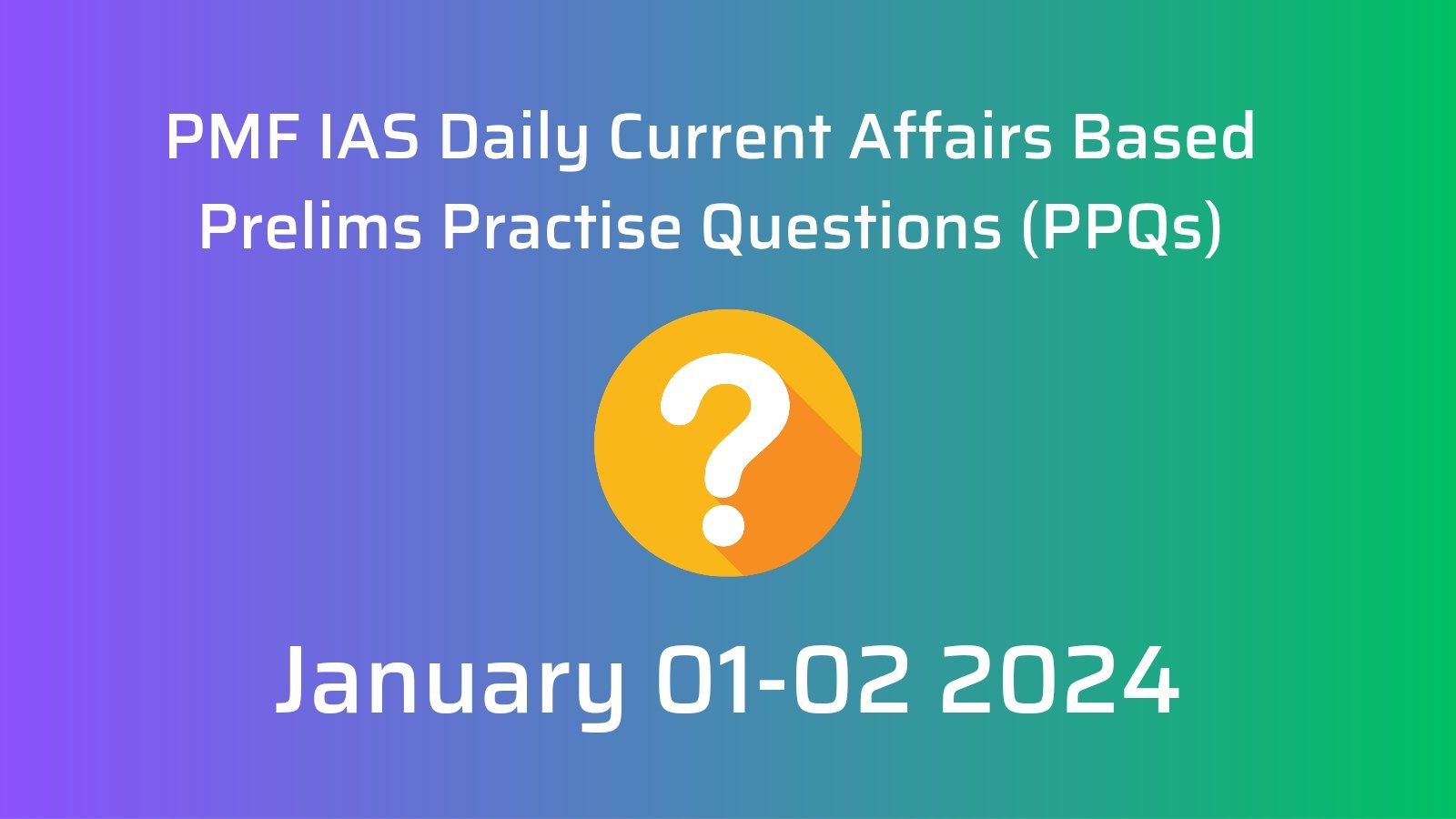
January 01-02 2024 Prelims Practice Questions (PPQs)
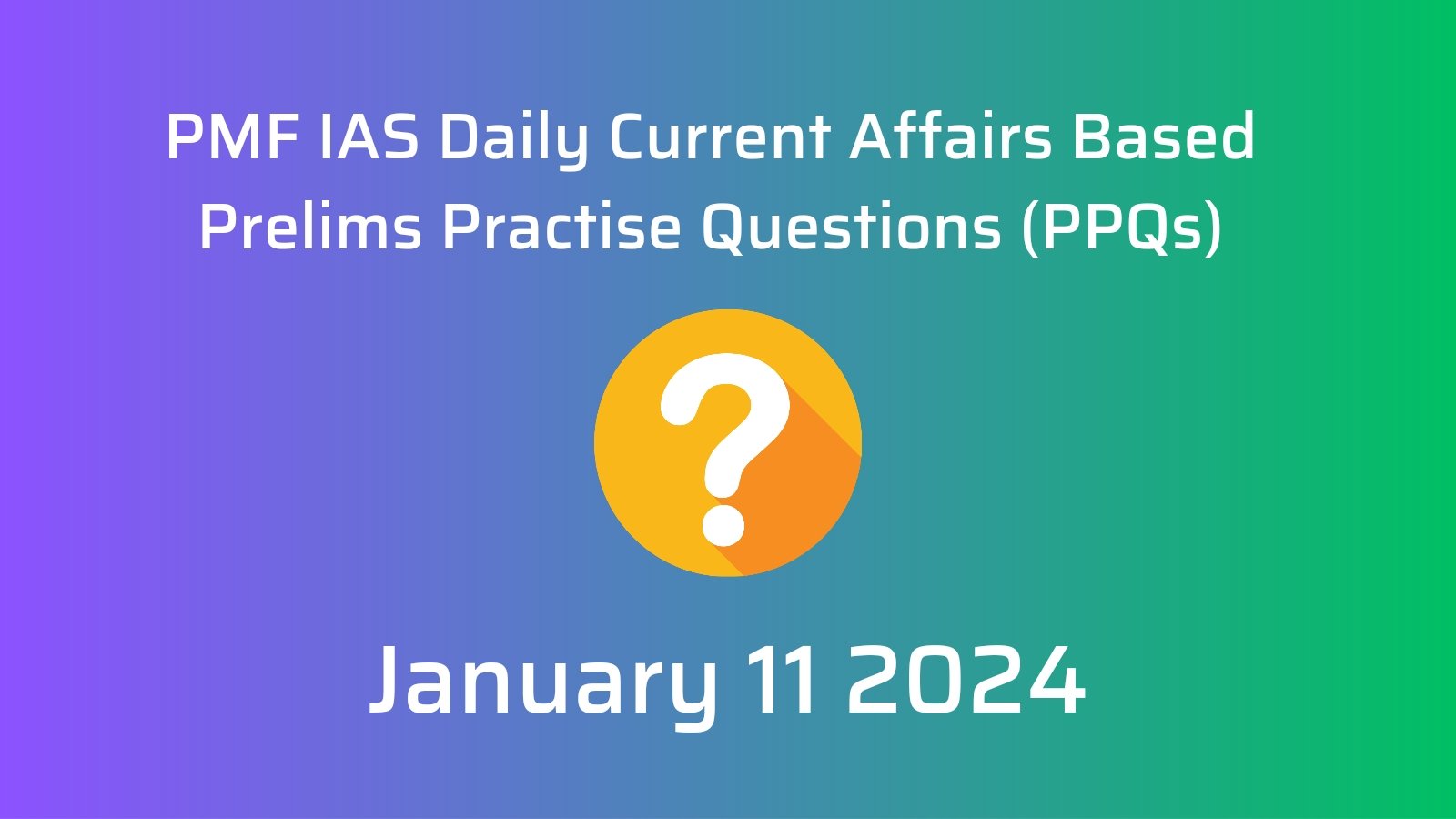
January 11 2024 Prelims Practice Questions (PPQs)
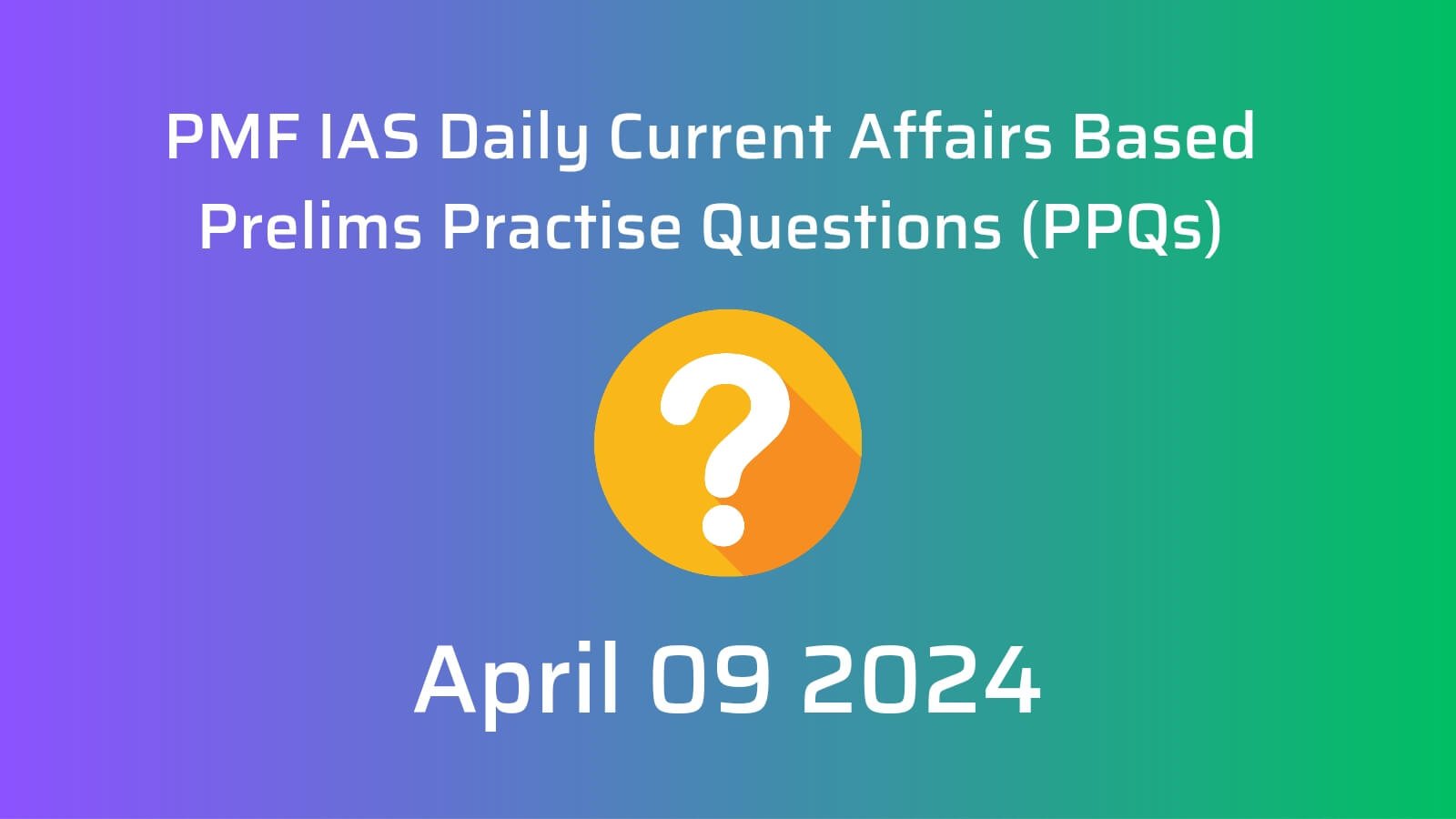
April 09 2024 Prelims Practice Questions (PPQs)
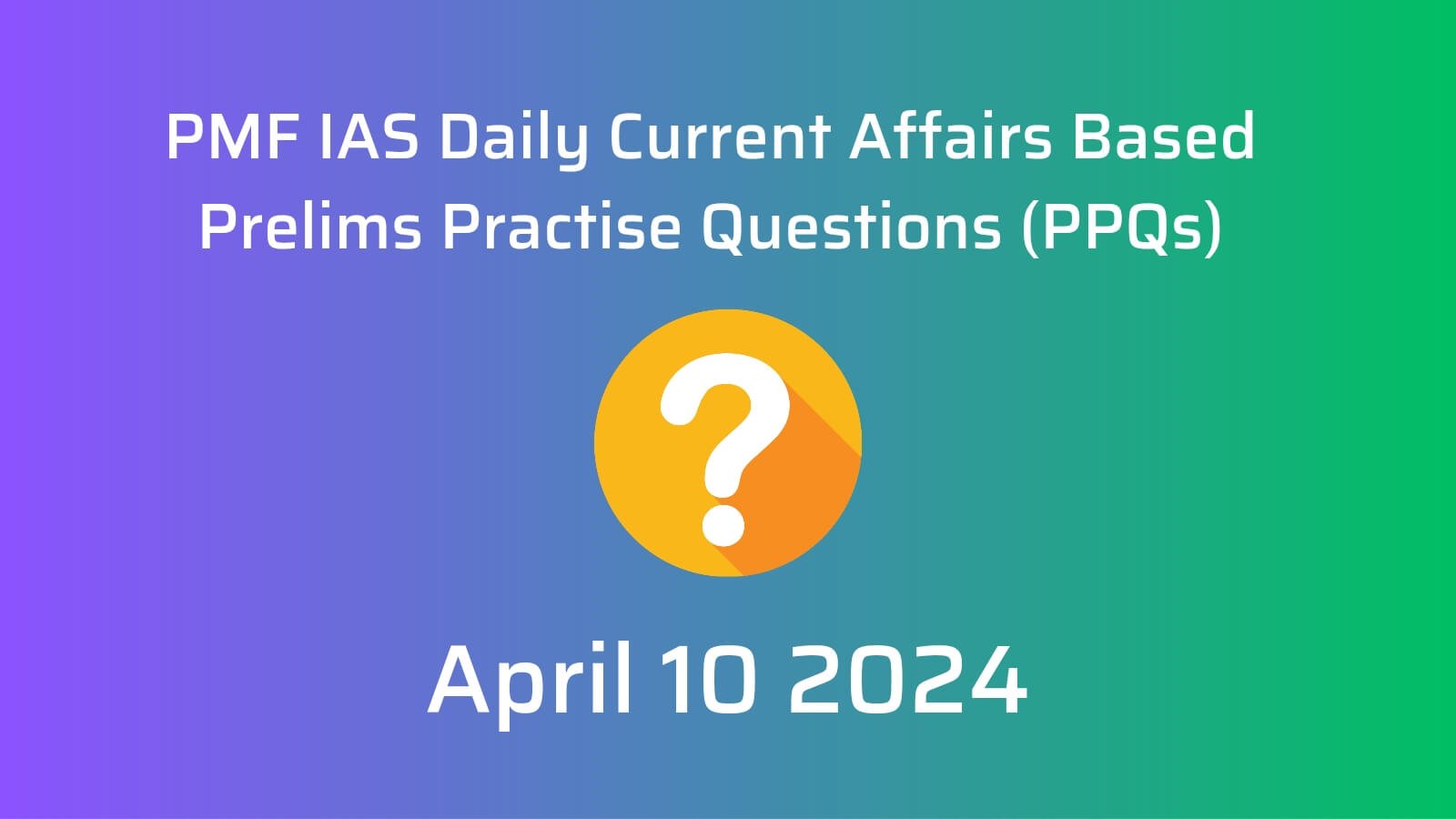
April 10 2024 Prelims Practice Questions (PPQs)
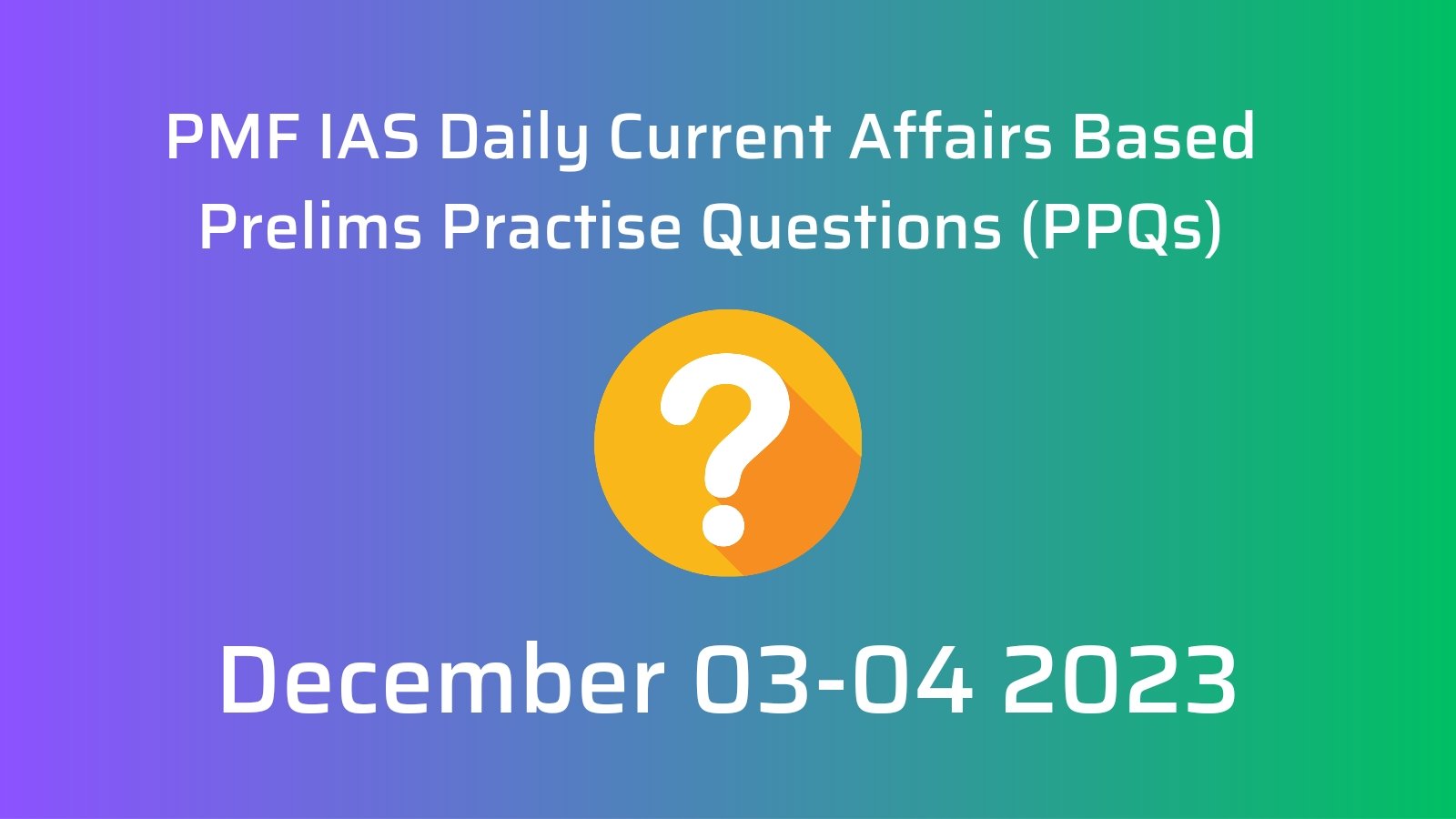
December 03-04 2023 Prelims Practice Questions (PPQs)
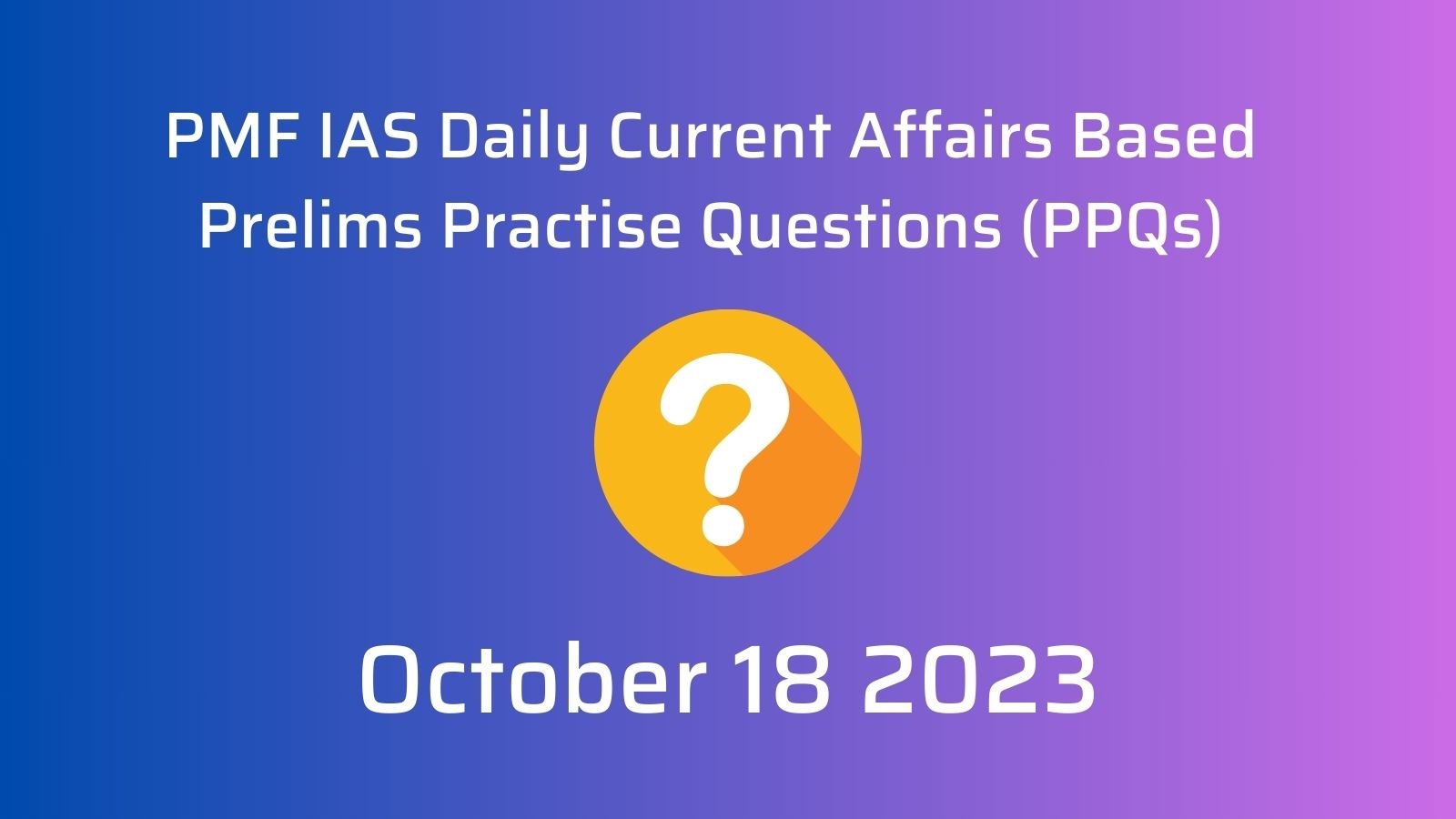
Daily Prelims Practise Questions (PPQs) – October 18 2023
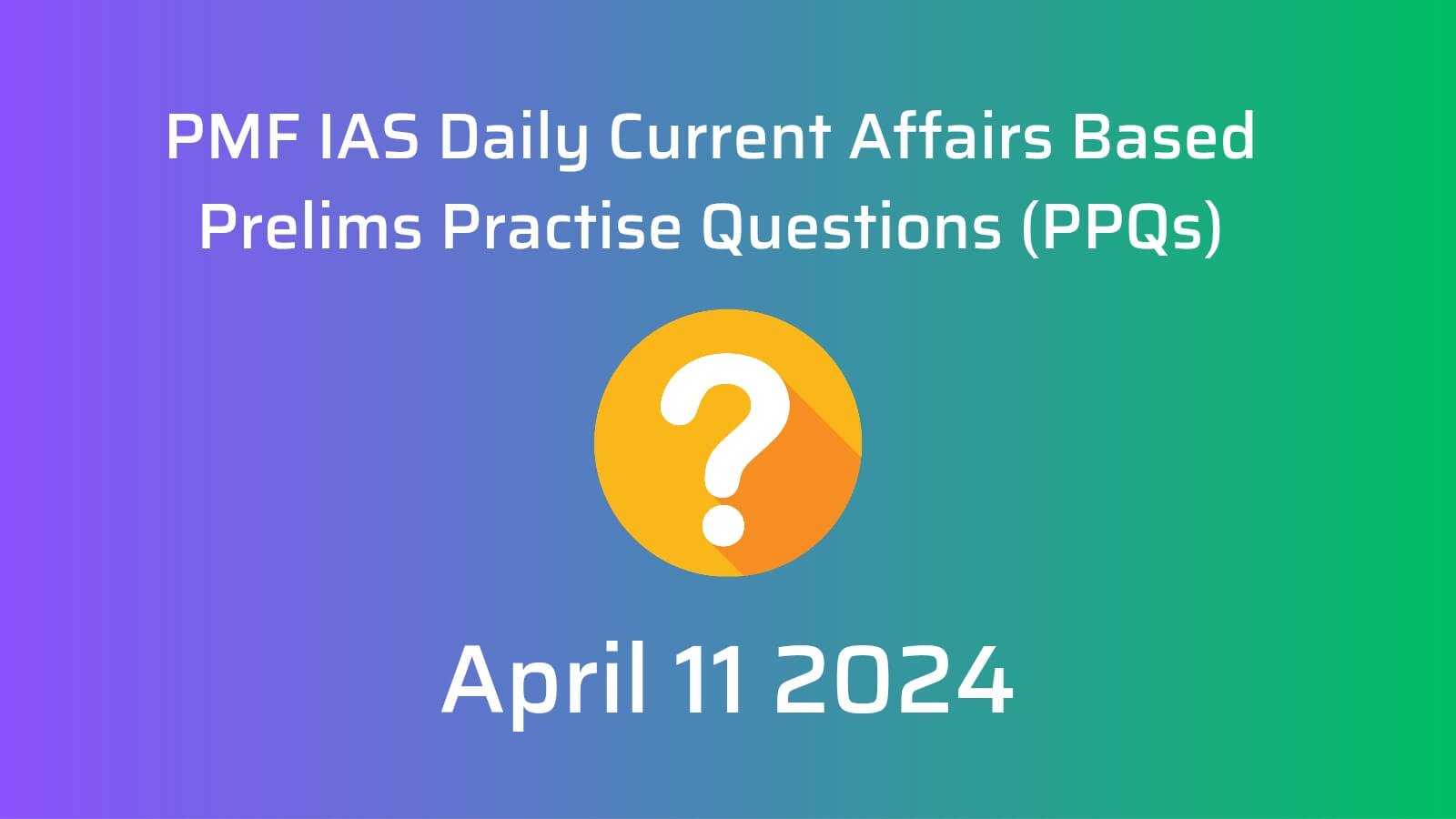
April 11 2024 Prelims Practice Questions (PPQs)
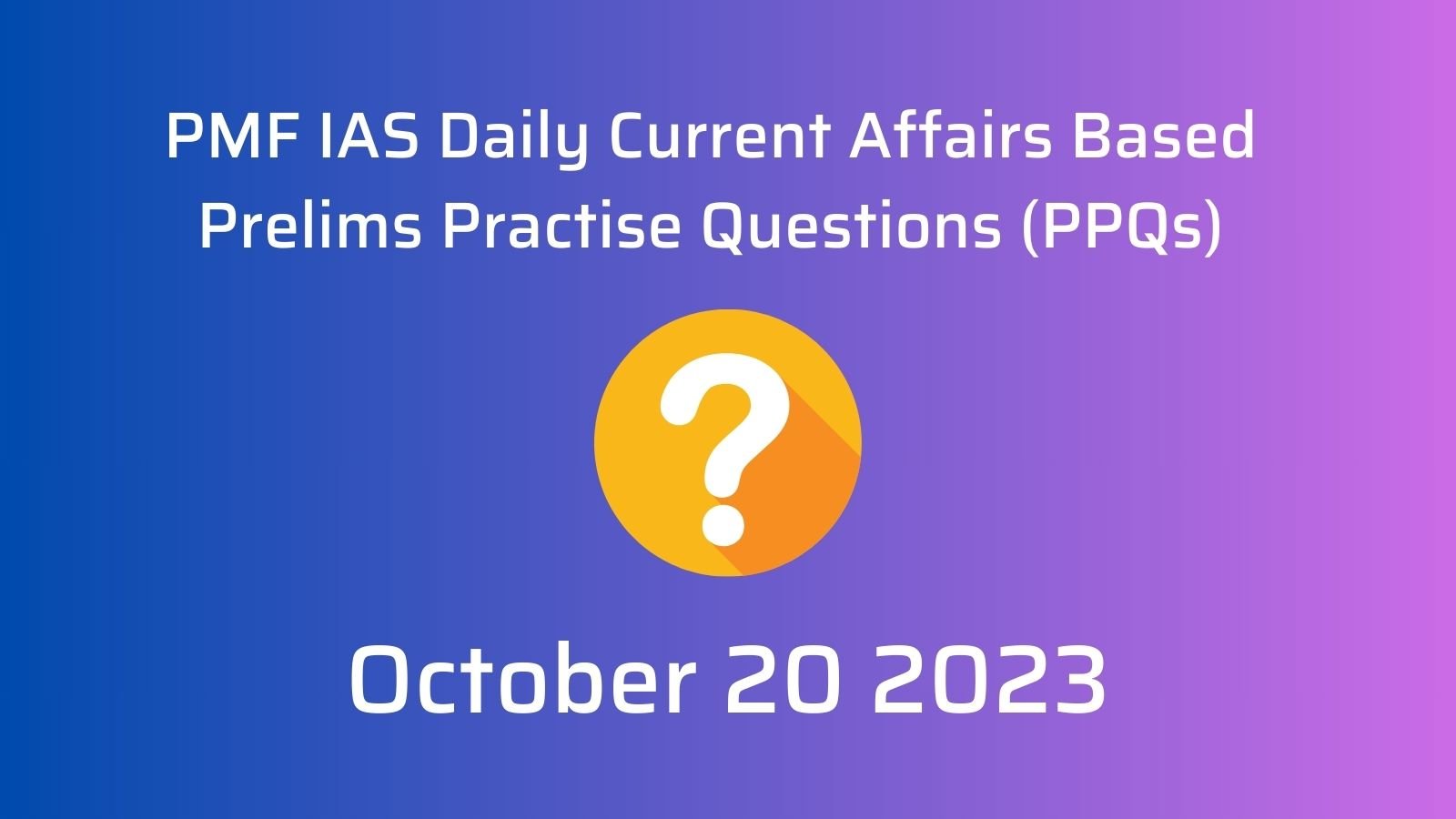




![PMF IAS Environment for UPSC 2022-23 [paperback] PMF IAS [Nov 30, 2021]…](https://pmfias.b-cdn.net/wp-content/uploads/2024/04/pmfiasenvironmentforupsc2022-23paperbackpmfiasnov302021.jpg)

